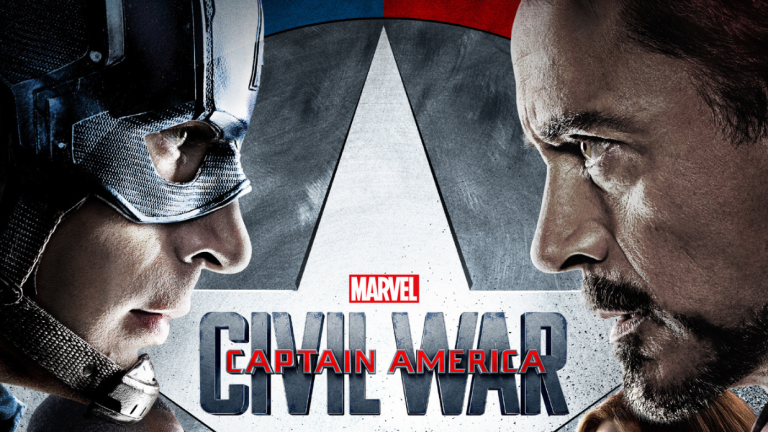Avengers vs. Avengers Can Be the Best Type of Superhero Story
Thunderbolts* might be setting up a battle between two sets of Avengers, and that's a good thing for fans... usually.

This article contains spoilers for Thunderbolts*.
Poor Thunderbolts. Nothing ever goes right for them.
Within seconds of Valentina Allegra de Fontaine renaming the team the New Avengers, the final credits of Thunderbolts* feature newspaper headlines mocking them as Earth’s Less-Than-Mightiest Heroes. Even worse is the post-credit scene, set 14 months later, the group is revealed griping about Captain America’s Avengers and how Sam Wilson is suing them. We even get hints at a rift between Bucky and Sam Wilson.
Bad as that state of affairs may be for the New Avengers, it’s good news for fans. Superhero on superhero fights are a staple of the genre, and a principle on which the Marvel Universe is founded. When hero fights hero, we get a chance to not just compare power levels, but to also measure different methods to achieving the same goals, enriching the characters in the process.
Earth’s Most Contentious Heroes
Fundamentally, the Avengers are a team of heroes who fight one another. Twelve pages into 1963’s Avengers #1, by Stan Lee and Jack Kirby, Ant-Man and the Wasp attack the Hulk. Sure, the trickster god Loki drove the heroes against one another, but when Iron Man and Thor join in the battle, Earth’s Mightiest Heroes decide to band together and reform into the Avengers. So fundamental is this storyline that 2012’s The Avengers features Loki manipulating Hulk into rampaging against his teammates while Thor, Captain America, and Iron Man face off earlier in the film.
It’s a plot point that gets repeated time and again in the pages of Marvel Comics. The Swordsman makes his debut in Avengers #19 (1965). Two years later in Avengers #42, Hank Pym gets manipulated by Fantastic Four villain Diablo into fighting his teammates. In fact, every one or two years, the Avengers must do battle with one another for one reason of another.
Easily the most infamous Avengers vs. Avengers battle, though, came during the Civil War storyline, which launched shortly after the inauguration of the New Avengers in 2005. Initially formed by both Captain America and Iron Man, the New Avengers found themselves at cross purposes after the actions of an upstart team called the New Warriors resulted in the deaths of 600 people. While Iron Man supported the subsequent government-sponsored Superhero Registration Act, Captain America rebelled. The general gist of this conflict was of course recreated for the third Captain America film as well.
Civil War spawned several years worth of stories about Avengers fighting Avengers, as Iron Man led a public-facing pro-registration team while Luke Cage led the underground Secret Avengers. In 2016, Marvel even launched Civil War II, in which the heroes once again split, this time because Captain Marvel used the powers of a clairvoyant character to stop threats before they manifest, a position opposed by Iron Man.
Even the much-loved Jonathan Hickman run on Avengers and New Avengers, both part of his epic storyline that began in Fantastic Four and culminated in Secret Wars, features two teams battling one another as much as they do the Incursions that threaten to destroy reality. While helping Captain America build a massive do-gooder team of Avengers, Iron Man also worked with the Illuminati to make morally-gray decisions and stop reality-destroying incursions, all depicted in the pages of New Avengers.
In almost all of these cases, fans grumbled, complaining that the conflicts felt arbitrary and out-of-character for the heroes. And yet, they do big numbers and continue to draw fans. Why? Because they’re fun!
Battle Builds Character
The subreddit Who Would Win currently has 562,000 members, each of whom comes to debate how fictional characters would stack up against one another. And that’s not the only place the discussion happens. Search any comic book fan subreddit on the site, and you’ll find people making passionate arguments, despite the fact that the characters’ power sets vary wildly according to circumstances and writer.
But the best hero vs. hero stories work because they reveal something about the character as a person, not just as a fighter. Take the scene from Civil War #6, in which the Punisher briefly joins Captain America’s team after saving Spider-Man and then guns down a pair of supervillains who also want to oppose registration. A horrified Cap pummels him for killing people in cold blood, but Punisher refuses to fight back. Even at his most delusional, Punisher respects Steve Rogers too much to raise a hand against him.
Likewise there’s the scene in 2007’s New Avengers #2, written by Brian Michael Bendis and illustrated by Leinil Francis Yu, in which Iron Man’s Avengers fight Cage’s Secret Avengers. When Doctor Strange launches a magical attack against Iron Man’s team, we readers see the insecurities driving the pro-registration heroes. Sentry witnesses himself becoming the Void, Black Widow recalls getting condemned by her Soviet colleague Crimson Dynamo, and Iron Man gets attacked by a zombie Steve Rogers. The vulnerability they show in this moment does a lot of work to undo the damage of Civil War, making the pro-registration Avengers less authoritarians who want power for its own sake and more flawed people trying to make the best decision possible.
Perhaps the best modern example of character building via Avengers vs. Avengers fights comes in Hickman’s runs on Avengers and New Avengers. 2014’s Avengers #29, penciled by Yu, features a familiar beat, in which Captain America punches Iron Man. This time it’s because Cap has learned that Tony wiped his memory to prevent his disruption of the Illuminati’s actions.
Rather than break out into a full brawl, the contrast here comes from legitimate differences in opinions about an impossible situation. Tony sees the existential threat posed by the Incursions and initially tried to work with Steve to stop them. But when it becomes clear that Steve’s methods wouldn’t work, Tony and Doctor Strange wipe their friend’s memory. Yet even then, Tony respected Steve, as the memory wipes allowed Captain America to hold to his values and remain an icon, qualities that Iron Man and the rest of the Illuminati couldn’t afford.
While Hickman’s Avengers run demonstrates how to use inter-hero conflict for character building, there are plenty of examples of the opposite. Two terrible X-Men-focused crossovers around the same time, AvX and Inhumans vs X-Men saw the Avengers and the Inhumans, groups usually presented as heroes, actively attack mutants just for existing. When Captain America, a man who canonically had so little bigotry that it forced Magneto to pause his campaign against humanity (see: 1987’s X-Men vs. Avengers) starts preemptively locking up mutants before they can do anything wrong, we’ve lost the plot.
Avengers, Disassembled
Even if MCU fans don’t recall all the talk of Incursions in Doctor Strange in the Multiverse of Madness, it’s clear that Kevin Feige and co. are borrowing from Hickman’s work for the next set of Avengers movies, Doomsday and Secret Wars. Between the titles of those movies and the recent cast announcement for Doomsday, we can see that the heroes must band together and likely make difficult decisions as they try to prevent a multiversal event.
Obviously different heroes will have different opinions regarding that situation, a situation made worse by the fact that Sam Wilson’s Avengers are clearly being set up to not exactly like Bucky’s New Avengers. A fight between the two groups seems unavoidable.
Hopefully, Feige and the returning the Russo Brothers directors will take this page from Hickman’s book as well, using the differences between the Avengers and the New Avengers to make Bucky, Sam, and co. richer characters. But even if they don’t, and even if the fights are all arbitrary and unearned—well, that will be fun too. And it will be classic Avengers behavior, behavior they established all the way back in 1963.
Thunderbolts* is now playing in theaters.
